The Elements Of Locker Room Design
Locker room design can seem overwhelming.
But it doesn’t have to be.
While there is some uniqueness between different applications (gyms, schools, break rooms, etc.), the basics of designing a locker room remain the same.
We’ve written this article to lay out exactly what you’ll need to include in your locker room, as well as some example floor plans to help you visualize your completed project.
Let’s get started!
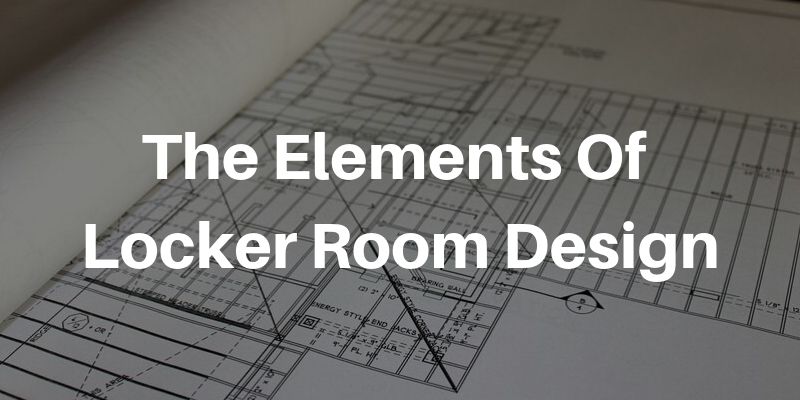
Choosing The Best Lockers
It isn’t a surprise that lockers will be the biggest part of your “locker” room design.
Depending on your needs, you might want to choose from plastic, wood, or metal lockers.
Let’s take a look at the pros and cons of each.
Plastic Lockers
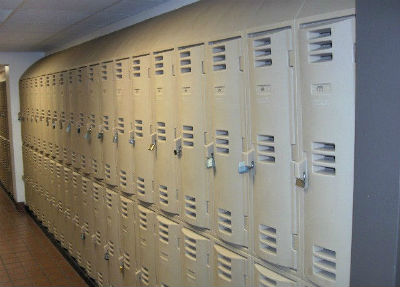
Although these lockers can often come with a higher up-front cost, the cost over time of plastic lockers tends to be the lowest.
This is due to them being rust, corrosion, and water-resistant.
This durable option will also tend to last you the longest, as typically metal lockers will rust and wood lockers are prone to water damage.
The plastic material used (LDPE) in our lockers is a solid color (of your choice) throughout, which means they help to hide scratches.
Guests will also be pleased with the quietness of opening and closing plastic lockers.
Your wallet will also thank you when it comes time to maintain this locker option, as they will require the least amount of maintenance between the 3.
One concern buyers often have with plastic is that it might be flimsy or be easily broken.
The structural integrity of lockers made from plastic actually makes them harder to break than traditional metal lockers.
We wrote a whole article on plastic vs metal lockers if you are interested!
Metal Lockers
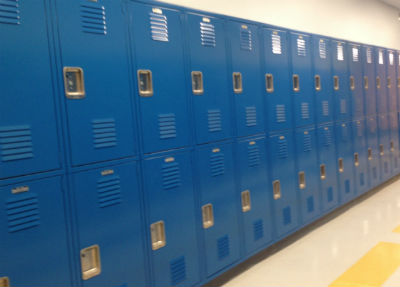
Often that comes accompanied with a memory of your high school hallways or locker rooms.
Metal lockers have been around for a very long time and have improved over the years.
They are the cheapest option upfront and are very sturdy.
The problems that metal lockers face are that they are:
- Prone to rust and corrosion
- Paint chips and will need to be repainted over time to prevent rust
- Dents and scrapes show very easily
- Due to the other issues, maintenance costs are often the highest of the 3 materials
Depending on where your locker room is located, you may not want the noisy slams of a metal locker door either.
All things to consider while selecting metal lockers.
Wood Lockers
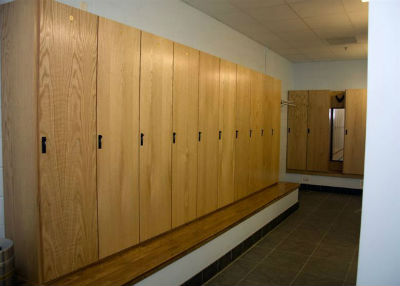
They are also popular with high level athletic’s locker rooms.
While they do have a nice look, as mentioned before they are prone to water damage.
This can become an issue if your lockers are placed too close to places with heavy moisture, such as showers, pools, or a sauna.
When wood lockers get water in them they become waterlogged, which will cause them to expand or fall apart.
Wood lockers are porous, meaning they can house and grow odor and bacteria.
That is why you don’t see wood lockers being used in gyms very often.
If you are looking for an elegant locker choice and don’t have to worry about the common problems, wood lockers are for you.
A Quick View of Locker Materials
| Metal | Plastic | Wood | |
|---|---|---|---|
| Price | $ | $$ | $$$ |
| Durability | Medium | High | Medium |
| Water Resistant | No | Yes | No |
| Corrosion Resistant | No | Yes | No |
| Maintenance | High | Low | Medium |
Locker Styles & Sizes
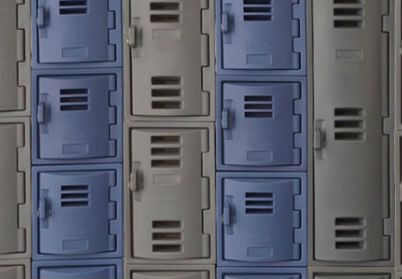
It’s important to think about what your lockers will be used for before you purchase.
If clients will be showing up needed to hang up work clothes (i.e. if they plan to work out before going into work), then taller lockers with hanging space will be needed.
If backpacks, books, etc. will need to be stored, then hanging space isn’t as much of an issue.
Shorter but wider or deeper lockers may be used in this case.
Sometimes all clients will need is to store small items such as their cellphones or shoes, in which case small lockers may be used.
Once you have a general idea of what your lockers will be used for you can pick the correct size.
You may also decide that your lockers will be used in multiple ways, in which you can opt for a variety of sizes in your locker room.
Check out the table below for reference on the locker sizes Fibertech offers (different sizes can be connected together).
Keep in mind the larger the locker size the less you can fit in your locker room.
Estimating the amount of traffic your locker room will get will prevent you from purchasing too little and upsetting your customers or purchasing too many and cramming your locker room.
You’ll also need to purchase ADA accessible handicap lockers as well (more on that later).
Locker Colors
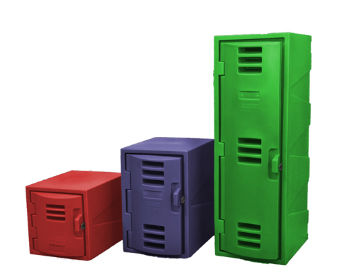
Most pre-built metal lockers will come in a uniform color unless custom ordered.
You do have some freedom with selecting the color of wood lockers without needing paint since each type of wood is a different color.
Plastic lockers come in the exact color you order.
And since the color comes from the material itself, scratches won’t ruin anything.
If you are looking to coordinate locker colors to match your brand, be sure to plan this out before you purchase.
And keep in mind that if you do decide to use paint that it will eventually chip off.
For metal lockers, this means you’ll need to repaint in order to prevent rust from spreading.
Locker Room Seating
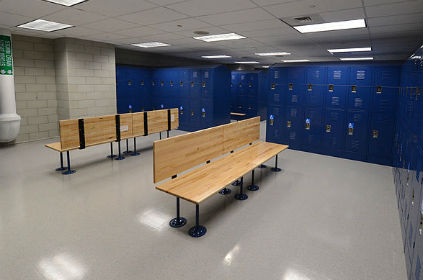
This will also depend on the use of your locker room, but generally speaking, you will want seating options to allow guests to have a place to tie their shoes, wait for their turn for the shower, etc.
There are many material choices for benches, including wood, plastic laminate, stainless steel and aluminum.
You will likely want to choose the material of your benches based on your locker material and color.
And if you are planning your locker room to be more of a break room style, adding tables with benches can be great for employees to relax at.
Bathrooms, Showers, & Other Amenities
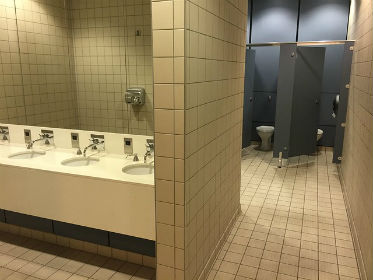
Tiled showers look nice, but there are other options that don’t require grout, which can help save time while cleaning.
Following a similar pattern to the items previously listed, bathroom/shower partitions are available in a wide variety of materials and colors.
Because of this, it is recommended to follow the same color scheme and style of the lockers and seating that you have chosen.
For showers, you have the option to add curtains or a door at the front of the stall for privacy, as well as hooks and benches to allow guests to place their clothing.
Having a dedicated area for freshening up can also be nice for guests that need to fix their hair or makeup.
Depending on your locker room purpose, vending machines and water fountains may be appropriate amenities to add.
Privacy, Safety & Security
If your locker room has bathrooms and showers, privacy should be a number one priority.
Adding partitions and stalls, as well as curtains or doors for showers is necessary.
While some may be fine with a more open style, having privacy options available helps everyone to be more comfortable.
Along with privacy, safety should also be a concern while creating a locker room design.
Selecting a flooring option that is slip-resistant will help guests from slipping and being injured.
Making sure your locker room is constructed by professionals can also help guests to remain safe.
You will also want to plan your fire exits to be up to code, as well as have proper signage that shows guests where to exit should they need to in an emergency.
Lastly, locker security can either be on your end or the guests.
Depending on the purpose of your locker room, you may opt to have guests bring their own locks and secure their items at their own risk.
If this is the case, it is very important to make sure that the lockers you are purchasing have places for locks already installed.
The ADA Guidelines For Locker Rooms
The Americans with Disabilities Act (ADA) was put in place to ensure access to amenities for those with disabilities.
As such, your locker room design needs to incorporate amenities that are accessible to everyone.
A licensed contractor who specializes in locker room design should have these handy while discussing locker room layouts.
Lockers
5% or more of all lockers, with a minimum of 1, should adhere to the following:
- Clear floor space at least 30 inches by 48 inches that allows either a forward or parallel approach by a person using a wheelchair
- Depending on the reach needed (see 4.2.5 of the ADAAG), the lockers shelves should not exceed 54 inches or be below 9 inches
Benches
You must have at least one bench that adheres to the following (source):
- Benches shall be fixed and shall have seats that are 20 inches minimum to 24 inches maximum in depth and 42 inches minimum in length
- Benches shall have back support that is 42 inches minimum in length and that extends from a point 2 inches maximum above the seat to a point 18 inches minimum above the seat
- Optional: back support may be achieved by placing benches adjacent to walls or other designs as long as they meet the minimum requirements.
Depending on the design of your locker room, you may be able to place a bench against the wall to create an ADA-approved bench for visitors.
Bathroom Stalls
There is a little bit of variety when it comes to the parameters needed to be met for bathroom stalls.
The differences are based on how large the stall itself is.
For example, if the stall is only 56 inches in depth, then you must use a wall-mounted toilet.
However, if the stall is 59 inches or more in depth, then a floor mounted toilet may be used.
For the full guidelines on stall dimensions, toe clearance, grab bar placement, etc. click here.
Shower Stalls
Shower stalls also have variety with them.
For the necessary shower stall dimensions, seat and grab bar configurations, controls, etc. click here.
You will need at least one ADA-compliant shower stall if you provide showers in your locker room.
Now It’s Time To Put The Pieces Together
Once you break things down into individual pieces, designing a locker room isn’t as daunting as it originally seems.
As mentioned before, a licensed contractor can help you with incorporating ADA compliant pieces, and they will have some sample layouts available for you to check out.
All that is left to do is pick out the materials and colors of your locker room and you’re all set!







